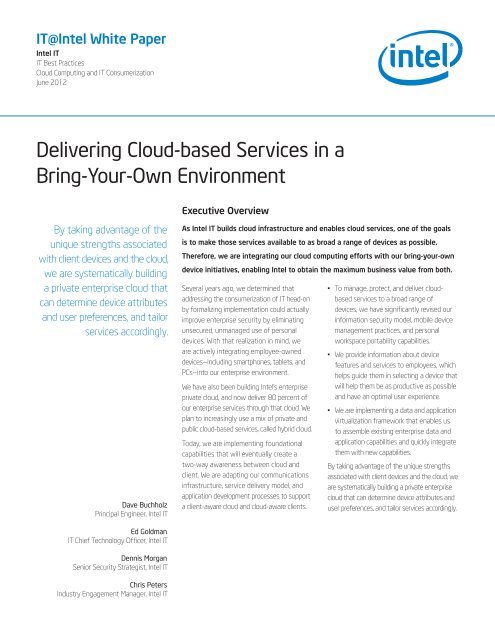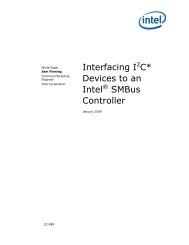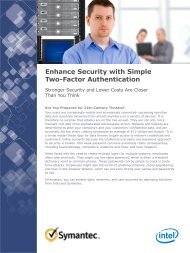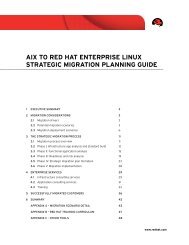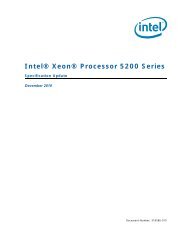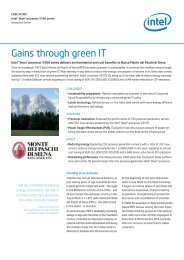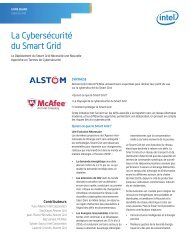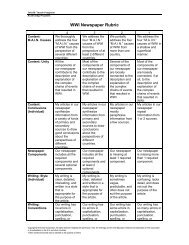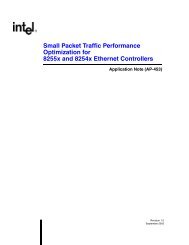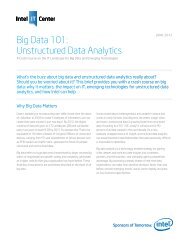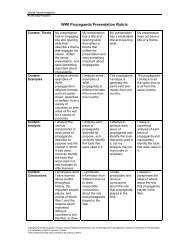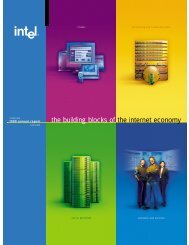Delivering Cloud-based Services in a Bring-Your-Own ... - Intel
Delivering Cloud-based Services in a Bring-Your-Own ... - Intel
Delivering Cloud-based Services in a Bring-Your-Own ... - Intel
Create successful ePaper yourself
Turn your PDF publications into a flip-book with our unique Google optimized e-Paper software.
IT@<strong>Intel</strong> White Paper<strong>Intel</strong> ITIT Best Practices<strong>Cloud</strong> Comput<strong>in</strong>g and IT ConsumerizationJune 2012<strong>Deliver<strong>in</strong>g</strong> <strong>Cloud</strong>-<strong>based</strong> <strong>Services</strong> <strong>in</strong> aBr<strong>in</strong>g-<strong>Your</strong>-<strong>Own</strong> EnvironmentExecutive OverviewBy tak<strong>in</strong>g advantage of theunique strengths associatedwith client devices and the cloud,we are systematically build<strong>in</strong>ga private enterprise cloud thatcan determ<strong>in</strong>e device attributesand user preferences, and tailorservices accord<strong>in</strong>gly.Dave BuchholzPr<strong>in</strong>cipal Eng<strong>in</strong>eer, <strong>Intel</strong> ITAs <strong>Intel</strong> IT builds cloud <strong>in</strong>frastructure and enables cloud services, one of the goalsis to make those services available to as broad a range of devices as possible.Therefore, we are <strong>in</strong>tegrat<strong>in</strong>g our cloud comput<strong>in</strong>g efforts with our br<strong>in</strong>g-your-owndevice <strong>in</strong>itiatives, enabl<strong>in</strong>g <strong>Intel</strong> to obta<strong>in</strong> the maximum bus<strong>in</strong>ess value from both.Several years ago, we determ<strong>in</strong>ed thataddress<strong>in</strong>g the consumerization of IT head-onby formaliz<strong>in</strong>g implementation could actuallyimprove enterprise security by elim<strong>in</strong>at<strong>in</strong>gunsecured, unmanaged use of personaldevices. With that realization <strong>in</strong> m<strong>in</strong>d, weare actively <strong>in</strong>tegrat<strong>in</strong>g employee-owneddevices—<strong>in</strong>clud<strong>in</strong>g smartphones, tablets, andPCs—<strong>in</strong>to our enterprise environment.We have also been build<strong>in</strong>g <strong>Intel</strong>’s enterpriseprivate cloud, and now deliver 80 percent ofour enterprise services through that cloud. Weplan to <strong>in</strong>creas<strong>in</strong>gly use a mix of private andpublic cloud-<strong>based</strong> services, called hybrid cloud.Today, we are implement<strong>in</strong>g foundationalcapabilities that will eventually create atwo-way awareness between cloud andclient. We are adapt<strong>in</strong>g our communications<strong>in</strong>frastructure, service delivery model, andapplication development processes to supporta client-aware cloud and cloud-aware clients.• To manage, protect, and deliver cloud<strong>based</strong>services to a broad range ofdevices, we have significantly revised our<strong>in</strong>formation security model, mobile devicemanagement practices, and personalworkspace portability capabilities.• We provide <strong>in</strong>formation about devicefeatures and services to employees, whichhelps guide them <strong>in</strong> select<strong>in</strong>g a device thatwill help them be as productive as possibleand have an optimal user experience.• We are implement<strong>in</strong>g a data and applicationvirtualization framework that enables usto assemble exist<strong>in</strong>g enterprise data andapplication capabilities and quickly <strong>in</strong>tegratethem with new capabilities.By tak<strong>in</strong>g advantage of the unique strengthsassociated with client devices and the cloud, weare systematically build<strong>in</strong>g a private enterprisecloud that can determ<strong>in</strong>e device attributes anduser preferences, and tailor services accord<strong>in</strong>gly.Ed GoldmanIT Chief Technology Officer, <strong>Intel</strong> ITDennis MorganSenior Security Strategist, <strong>Intel</strong> ITChris PetersIndustry Engagement Manager, <strong>Intel</strong> IT
IT@<strong>Intel</strong> White Paper<strong>Deliver<strong>in</strong>g</strong> <strong>Cloud</strong>-<strong>based</strong> <strong>Services</strong> <strong>in</strong> a Br<strong>in</strong>g-<strong>Your</strong>-<strong>Own</strong> EnvironmentContentsExecutive Overview.............................. 1Background............................................. 2Solution.................................................... 2Communications InfrastructureChanges............................................... 3Service Delivery Changes................. 4Application DevelopmentChanges............................................... 7Conclusion............................................... 7For More Information .......................... 7Acronyms................................................. 8IT@<strong>Intel</strong>The IT@<strong>Intel</strong> program connects ITprofessionals around the world with theirpeers <strong>in</strong>side our organization – shar<strong>in</strong>glessons learned, methods and strategies.Our goal is simple: Share <strong>Intel</strong> IT bestpractices that create bus<strong>in</strong>ess value andmake IT a competitive advantage. Visitus today at www.<strong>in</strong>tel.com/IT or contactyour local <strong>Intel</strong> representative if you’dlike to learn more.Background<strong>Intel</strong> employees want to be ableto use a broad range of companiondevices, <strong>in</strong>clud<strong>in</strong>g personally ownedsmartphones and tablets, with their<strong>Intel</strong>-supplied mobile bus<strong>in</strong>ess PCs.They also want to be able to usetheir personally owned Macs* andPCs. We determ<strong>in</strong>ed that address<strong>in</strong>gthe consumerization of IT head-onby formaliz<strong>in</strong>g implementation couldactually improve enterprise security,help<strong>in</strong>g to elim<strong>in</strong>ate unsecuredand unmanaged use of personaldevices. <strong>Intel</strong> IT is actively <strong>in</strong>tegrat<strong>in</strong>gemployee-owned devices <strong>in</strong>to ourenterprise environment.In early 2010, about 3,000 <strong>Intel</strong> employeeswere us<strong>in</strong>g personally owned smartphones;by the end of June 2012, this number had<strong>in</strong>creased to 19 ,000. Also <strong>in</strong> 2011 someemployees began us<strong>in</strong>g their personal Apple*computers, and this year we are expand<strong>in</strong>gour br<strong>in</strong>g-your-own-device (BYOD) <strong>in</strong>itiativeto <strong>in</strong>clude PCs. We are transition<strong>in</strong>g from thetraditional client comput<strong>in</strong>g model of a limitednumber of device types under tight and directIT control to a future compute cont<strong>in</strong>uummodel that focuses on a seamless, consistentexperience across devices. We see greatbus<strong>in</strong>ess value <strong>in</strong> allow<strong>in</strong>g employees morechoice <strong>in</strong> the devices they can use at work. Atthe same time, we realized we need to protect<strong>Intel</strong> <strong>in</strong>formation security by ma<strong>in</strong>ta<strong>in</strong><strong>in</strong>g controlof the underly<strong>in</strong>g communication <strong>in</strong>frastructurethat supports those devices.There are parallels and <strong>in</strong>terdependenciesbetween IT consumerization, which providesemployees with a wider range of choices forcompute capability, and the advent of cloudcomput<strong>in</strong>g, which offers bus<strong>in</strong>esses additionaloptions for IT services. At <strong>Intel</strong>, we have builtan extensive private enterprise cloud, andwe now deliver 80 percent of our enterpriseservices through that cloud. We plan tocont<strong>in</strong>ue mov<strong>in</strong>g toward a mix of private andpublic cloud services, called a hybrid cloud.As we cont<strong>in</strong>ue to build cloud <strong>in</strong>frastructureand enable cloud services and applications,it is important that we consider our BYOD<strong>in</strong>itiatives at the same time. This <strong>in</strong>tegratedapproach will enable <strong>Intel</strong> to obta<strong>in</strong> themaximum bus<strong>in</strong>ess value from both BYODand cloud comput<strong>in</strong>g.SolutionWe have found that the key todeliver<strong>in</strong>g cloud-<strong>based</strong> services toa wide variety of devices, <strong>in</strong>clud<strong>in</strong>gBYO devices, is to create a two-wayawareness between the cloud and theclient. Not all client devices have thesame capabilities, and the cloud is notalways available to a client device.Therefore, a one-size-fits-all servicedelivery model is not appropriate. Amisalignment between the deliverymodel and the device could negativelyaffect employee productivity andbus<strong>in</strong>ess functionality, <strong>in</strong>troducesecurity risk, and <strong>in</strong>validate the<strong>in</strong>vestment made <strong>in</strong> develop<strong>in</strong>g cloud<strong>based</strong>services and applications.By tak<strong>in</strong>g advantage of the unique strengthsassociated with the device and the cloud, weare systematically build<strong>in</strong>g a private enterprisecloud that can determ<strong>in</strong>e device attributes anduser preferences, and tailor services accord<strong>in</strong>gly.Although it will take several years to completeour efforts, we are already work<strong>in</strong>g to establishthe necessary foundational capabilities over thenext few months.2 www.<strong>in</strong>tel.com/IT
<strong>Deliver<strong>in</strong>g</strong> <strong>Cloud</strong>-<strong>based</strong> <strong>Services</strong> <strong>in</strong> a Br<strong>in</strong>g-<strong>Your</strong>-<strong>Own</strong> EnvironmentIT@<strong>Intel</strong> White PaperAs illustrated <strong>in</strong> Figure 1, our <strong>in</strong>telligent,client-aware cloud will be able to determ<strong>in</strong>ethe follow<strong>in</strong>g:• Whether an application provides thebest user experience if executed locallyor remotely• Which native features, such as a location<strong>based</strong>service provided by the GlobalPosition<strong>in</strong>g System or accelerometer, areavailable on a device• How to use predef<strong>in</strong>ed user and deviceprofiles to customize services to userpreferences and the device’s securityaccess levelConversely, we are also establish<strong>in</strong>gfoundational capabilities to enable cloudawareclient devices. For example, a clientdevice will be able to determ<strong>in</strong>e the follow<strong>in</strong>g:• Whether the cloud is available• What services are available to the clientdevice at the time• Its security level and available bandwidthFor example, if the cloud is available, the devicestores a document <strong>in</strong> a cloud-<strong>based</strong> documentrepository. But, if the cloud isn’t available,the device stores the document locally andpossibly automatically uploads the documentto the cloud when it becomes possible.<strong>Cloud</strong>-aware devices can also offloadwork from the cloud that might be moreefficiently done on the device, help<strong>in</strong>g toenhance the quality of service for end users.This type of work might <strong>in</strong>clude image andvideo process<strong>in</strong>g, data compression, and 2Dand 3D graphics. The 3rd generation <strong>Intel</strong>®Core processor family with <strong>Intel</strong>® TurboBoost Technology 2.0 and next-generationgraphics facilitate local execution on thedevice. Tak<strong>in</strong>g advantage of local resources<strong>in</strong> this manner helps reduce both the datacenter workload and the associated networktraffic. We are currently conduct<strong>in</strong>g severalproofs of concept to evaluate these typesof technologies and to establish enterpriseusage models.Implement<strong>in</strong>g a client-aware cloud andcloud-aware devices requires changes to thecommunications <strong>in</strong>frastructure, service deliverymodel, and application development processes.CommunicationsInfrastructure ChangesProvid<strong>in</strong>g cloud-<strong>based</strong> services to multipledevices and OSs requires several modificationsto our communications <strong>in</strong>frastructure,such as additional firewall controls. Theseadjustments are necessary because eachOS has different security features, andsome are more secure than others. Tosupport a broad range of personally owneddevices, we are build<strong>in</strong>g a communications<strong>in</strong>frastructure that uses a flexible comb<strong>in</strong>ationof delivery methods, <strong>in</strong>clud<strong>in</strong>g workspace andapplication conta<strong>in</strong>ers, application and desktopvirtualization, remote display technology,HTML5, and web portals, to deliver services toa wide variety of form factors, <strong>in</strong>clud<strong>in</strong>g PCs,Macs, tablets, and smartphones.To manage, protect, and deliver this flexibilitywe have made significant enhancements andadjustments to our <strong>in</strong>formation securitymodel, mobile device management practices,and personal workspace portability capabilities.Current Status:BandwidthProcess<strong>in</strong>g PowerGraphics CapabilitiesSecurityCurrent Status:BandwidthProcess<strong>in</strong>g PowerGraphics CapabilitiesSecurityCompute remotelyPlay high-def<strong>in</strong>ition (HD) videoMedium-security accessCurrent Status:BandwidthProcess<strong>in</strong>g PowerGraphics CapabilitiesSecurityCompute remotelyPlay non-HD videoLow-security access<strong>Cloud</strong>Compute locallyPlay HD videoSecure access<strong>Cloud</strong>-aware ClientClient-aware <strong>Cloud</strong>Figure 1. We are lay<strong>in</strong>g the foundation for a bidirectional awareness between the cloud and a client device that will enhance service delivery, userexperience, and productivity.www.<strong>in</strong>tel.com/IT 3
IT@<strong>Intel</strong> White Paper<strong>Deliver<strong>in</strong>g</strong> <strong>Cloud</strong>-<strong>based</strong> <strong>Services</strong> <strong>in</strong> a Br<strong>in</strong>g-<strong>Your</strong>-<strong>Own</strong> EnvironmentInformation security modelWe have found that security is of paramountimportance <strong>in</strong> be<strong>in</strong>g able to fully embracecloud comput<strong>in</strong>g and BYOD, and to seamlesslydeliver services to a broad range of devices.We have radically redesigned our securityarchitecture to enable different degrees ofaccess. Our new security model is <strong>based</strong> onfour pillars.• Identity and access management. <strong>Intel</strong>IT has created a unique <strong>in</strong>tegrated trustcalculation technology that enables us tosupport devices with differ<strong>in</strong>g levels ofsecurity. The system dynamically adjustsusers’ access privileges as their level of riskchanges. For example, employees have lessaccess to corporate <strong>in</strong>formation from personalsmartphones than from corporate laptops.• Security bus<strong>in</strong>ess <strong>in</strong>telligence. As weallow access to enterprise services frommore devices, we need improved detection,monitor<strong>in</strong>g, and analysis capabilities. Wedeployed a dashboard that provides detailed<strong>in</strong>formation about <strong>in</strong>fected clients andservers, boost<strong>in</strong>g our ability to <strong>in</strong>tervenequickly and accurately. We also plan to add apredictive eng<strong>in</strong>e that will help improve ourability to respond to threats.• Data protection. We are implement<strong>in</strong>gtechnologies that protect data when it iscreated, stored, and <strong>in</strong> transit. We expandedthe deployment of enterprise rightsmanagement software to nearly 20,000employees, and we implemented dataloss prevention technology to better tracksensitive data as it moves through <strong>Intel</strong>.• Infrastructure. We implemented securetrust zones with<strong>in</strong> our enterprise privatecloud that enable us to virtualize <strong>in</strong>ternallyand externally fac<strong>in</strong>g applications withhigher security requirements. As a result, wereduced malware <strong>in</strong>cidents by 30 percent,despite a 50-percent <strong>in</strong>crease <strong>in</strong> the numberof malware detections <strong>in</strong> 2011.Device ManagementA mobile device management (MDM) solutionprovides several important benefits with regardto BYOD. By controll<strong>in</strong>g and protect<strong>in</strong>g the dataand configuration sett<strong>in</strong>gs for all mobile devices<strong>in</strong> the network, MDM helps reduce support costsand bus<strong>in</strong>ess risks, help<strong>in</strong>g to enable the securedelivery of at least a limited set of services.The ma<strong>in</strong> functions of an MDM solutionare deploy<strong>in</strong>g software, <strong>in</strong>clud<strong>in</strong>g patchdeployment and configuration management,enabl<strong>in</strong>g remote troubleshoot<strong>in</strong>g, and provid<strong>in</strong>gthe ability to remotely lock and wipe a device.MDM solutions also provide a cost-effectiveand efficient method for system ma<strong>in</strong>tenance,such as the ability to replace a corruptedor failed image with a work<strong>in</strong>g image. Forexample, at the beg<strong>in</strong>n<strong>in</strong>g of a tra<strong>in</strong><strong>in</strong>g session,an <strong>in</strong>structor can verify that all the classroomdevices are functional and, if necessary,can quickly re-<strong>in</strong>stall the image on any nonfunction<strong>in</strong>gdevices.However, because our current MDM solutionworks only for devices that run mobile OSs andwe must use a separate corporate managementsystem for PCs, MDM does not resolve all of<strong>Intel</strong>’s remote device management problems.For example, our MDM remote wipe capabilitydoesn’t work on larger form factors such as PCs.For this reason, we currently consider personallyowned PCs to be at a lower trust level thansome mobile devices, such as tablets andsmartphones, unless the device’s owner decidesto opt <strong>in</strong> to corporate management capabilities.Workspace MobilitySupport<strong>in</strong>g BYOD devices raises challengesabout how to make data available regardlessof the user’s location—whether at work, athome, or travel<strong>in</strong>g—and how to deliver aconsistent workspace across a user’s manydevices, whether access<strong>in</strong>g cloud services orlocally <strong>in</strong>stalled applications.To support a more portable workspace, weare mov<strong>in</strong>g away from our traditional modelof locally <strong>in</strong>stalled applications to explor<strong>in</strong>ghow we can deliver more modular servicesto many different devices. One approach wehave <strong>in</strong>vestigated is to separate the layersof the traditional tightly coupled solutionsstack, a technique IT architects refer to asabstraction. By us<strong>in</strong>g virtualization to dividethe platform, OS, application, user data, anduser profile layers <strong>in</strong>to separate services, wecan set rules <strong>in</strong>dividually on each abstractedlayer of the service.Us<strong>in</strong>g abstraction we can determ<strong>in</strong>e whether,<strong>based</strong> on the type of device, user location,or other criteria, it’s appropriate to deliveran optimal service to a particular device. Forexample, smartphones can access contactlists, calendars, and email services only; fortablets, we are <strong>in</strong>vestigat<strong>in</strong>g the feasibilityof deliver<strong>in</strong>g an expanded set of bus<strong>in</strong>essto-bus<strong>in</strong>esscollaboration tools, such asnote-tak<strong>in</strong>g and archiv<strong>in</strong>g services, <strong>in</strong>stantvideo collaboration, and <strong>in</strong>stant meet<strong>in</strong>gs.Workspace mobility also raises the issue ofhow to synchronize cloud-<strong>based</strong> and localdata. We are currently explor<strong>in</strong>g how contentsynchronization may affect backup-andrestoreprocesses.Service Delivery ChangesBecause our goal is to enable cloud-<strong>based</strong>services that take advantage of featureson employees’ devices, we need to actas a trusted advisor, provid<strong>in</strong>g employees<strong>in</strong>formation about a device, whether it’s asmartphone, tablet, or PC. We encourageemployees to consider how they want towork and where they want to work with eachdevice. We then help them choose the deviceand OS that is best suited for their situation,help<strong>in</strong>g them to be as productive as possibleand to have an optimal user experience.4 www.<strong>in</strong>tel.com/IT
<strong>Deliver<strong>in</strong>g</strong> <strong>Cloud</strong>-<strong>based</strong> <strong>Services</strong> <strong>in</strong> a Br<strong>in</strong>g-<strong>Your</strong>-<strong>Own</strong> EnvironmentIT@<strong>Intel</strong> White PaperEmployees can choose among many differentdevices with vary<strong>in</strong>g levels of capabilities.The availability of a diversity of user<strong>in</strong>terfaces and screen sizes affects deviceand application <strong>in</strong>teraction. Some devices donot have the features necessary to meet them<strong>in</strong>imum security configuration for even thelowest level of confidential data classification.Other devices can access certa<strong>in</strong> data andservices, but not others. A small subsetof devices can access corporate data andservices, with restriction.With those factors <strong>in</strong> m<strong>in</strong>d, it isn’t possibleto deliver a one-size-fits-all service deliverymodel that delivers the same set of servicesto every personally owned device. Nor is itpractical to support every possible computemodel and OS. For example, we limit ourmobile device support to five mobile OSs; forBYOD computers, we currently support Macs*and plan to support Microsoft W<strong>in</strong>dows*-<strong>based</strong> systems <strong>in</strong> 2012, but we do not planto support L<strong>in</strong>ux*-<strong>based</strong> systems.To educate employees about which devicescan access which enterprise services andwhich devices and OSs are best for certa<strong>in</strong>work scenarios, we have created a web portalthat provides a wide variety of <strong>in</strong>formation toemployees enroll<strong>in</strong>g <strong>in</strong> our BYOD programs.Br<strong>in</strong>g <strong>Your</strong> <strong>Own</strong> PhoneTable 1 shows a part of our web site thatcompares smartphone features, help<strong>in</strong>gemployees choose the best device for theirsituation. For example, if an employee’s jobrequires good access to cloud-<strong>based</strong> bus<strong>in</strong>essand Internet applications, as well as Wi-Fi*access and access to the <strong>Intel</strong> <strong>in</strong>tranet, thechart <strong>in</strong>dicates that a smartphone with OS#5 is the best choice. On the other hand,if an employee needs only calendar andcontact <strong>in</strong>formation, any of the supportedsmartphones is adequate.Table 1. <strong>Intel</strong> Employees Can Use the Information on Our Handheld <strong>Services</strong> Web Portal to Compare Smartphone FeaturesFeature OS 1 OS 2 OS 3 OS 4 OS 5Email a a aAdditional security softwaremay be required, depend<strong>in</strong>gon the supported deviceCalendar a a a a aContacts a a a a aGlobal Position<strong>in</strong>g System (GPS) a a a aWi-Fi*Allows you to connect to your home network or public Wi-Fi<strong>in</strong> airport or coffeeshop, and other areasVaries Varies Varies a aInternet Usability Good Varies Varies Best BestInternet ApplicationsExamples: mapp<strong>in</strong>g applications, currency converters,and so onGood Good Good Better Best<strong>Intel</strong> Intranet Availability Some Available r r r Some AvailableBus<strong>in</strong>ess Application AvailabilityExamples: Instant messag<strong>in</strong>g, bridge speed dialer, and so onBattery LifeStandby or talkGlobal Roam<strong>in</strong>g CapabilityMore Available Some Available Some Available Less Available Some AvailableBest Good Good Good GoodVaries by Rate PlanTether<strong>in</strong>gConnect your phone to your laptop and use the phone as a modemto connect to the Internet (like a wireless data card). Performancevaries by phone model and service provider network speedaavailable; r unavailableaVaries by Country or Service Providerwww.<strong>in</strong>tel.com/IT 5
AcronymsBYOD br<strong>in</strong>g your own deviceMDM mobile device managementThis paper is for <strong>in</strong>formational purposes only. THIS DOCUMENT IS PROVIDED “AS IS” WITH NO WARRANTIES WHATSOEVER, INCLUDING ANY WARRANTYOF MERCHANTABILITY, NONINFRINGEMENT, FITNESS FOR ANY PARTICULAR PURPOSE, OR ANY WARRANTY OTHERWISE ARISING OUT OF ANYPROPOSAL, SPECIFICATION OR SAMPLE. <strong>Intel</strong> disclaims all liability, <strong>in</strong>clud<strong>in</strong>g liability for <strong>in</strong>fr<strong>in</strong>gement of any proprietary rights, relat<strong>in</strong>g to use of <strong>in</strong>formation <strong>in</strong>this specification. No license, express or implied, by estoppel or otherwise, to any <strong>in</strong>tellectual property rights is granted here<strong>in</strong>.<strong>Intel</strong>, the <strong>Intel</strong> logo, and <strong>Intel</strong> Core are trademarks of <strong>Intel</strong> Corporation <strong>in</strong> the U.S. and other countries.* Other names and brands may be claimed as the property of others.Copyright © 2013 <strong>Intel</strong> Corporation. All rights reserved. Pr<strong>in</strong>ted <strong>in</strong> USA Please Recycle 0612/JGLU/KC/PDF 327462-001US


